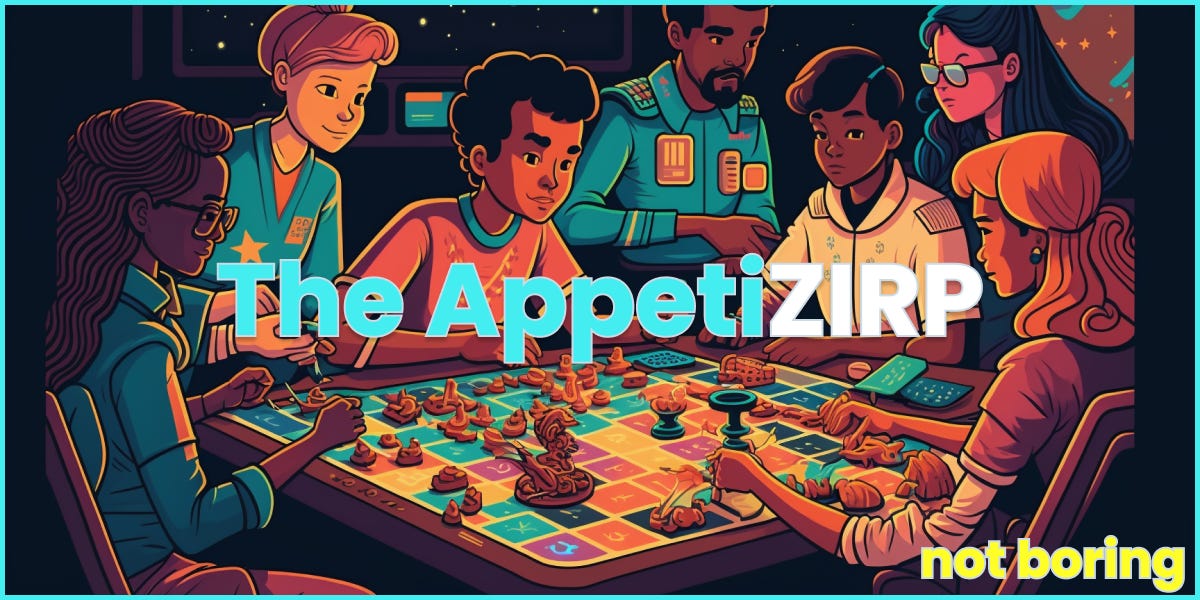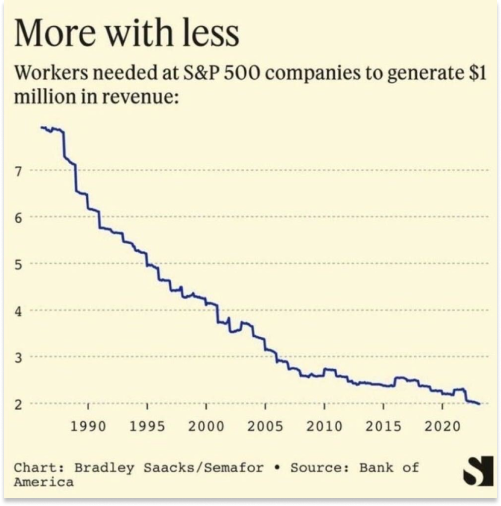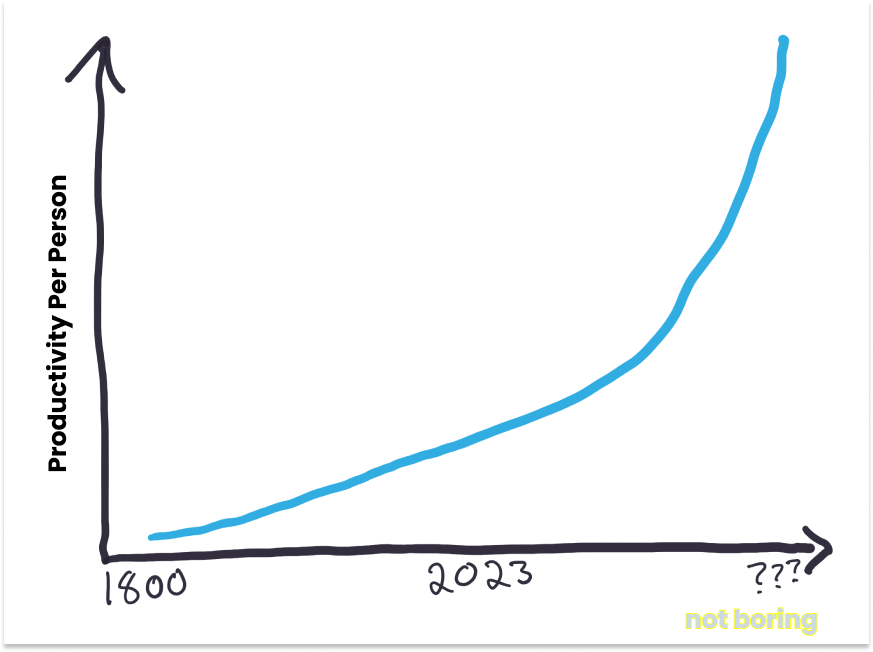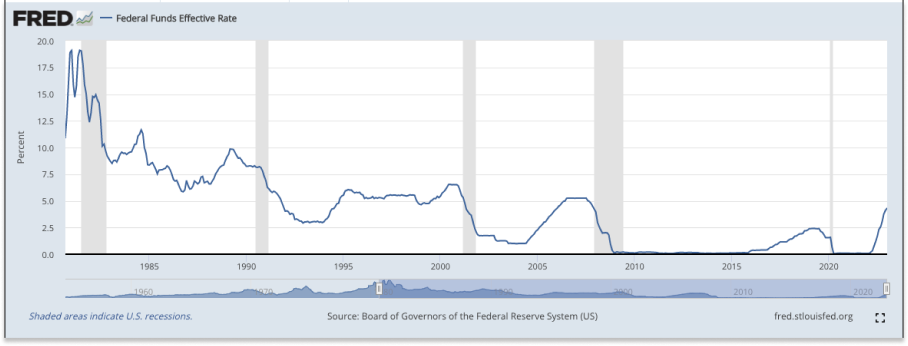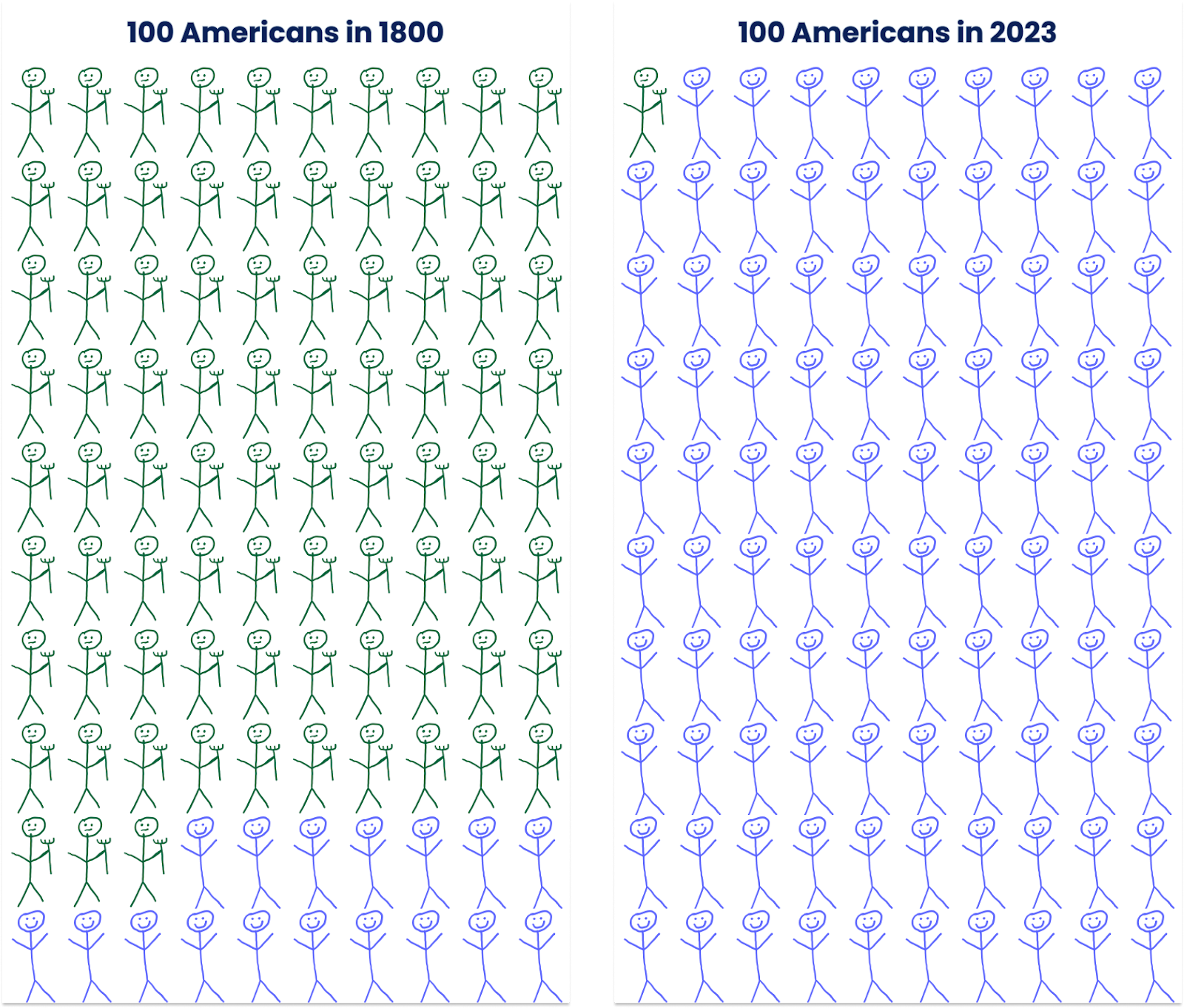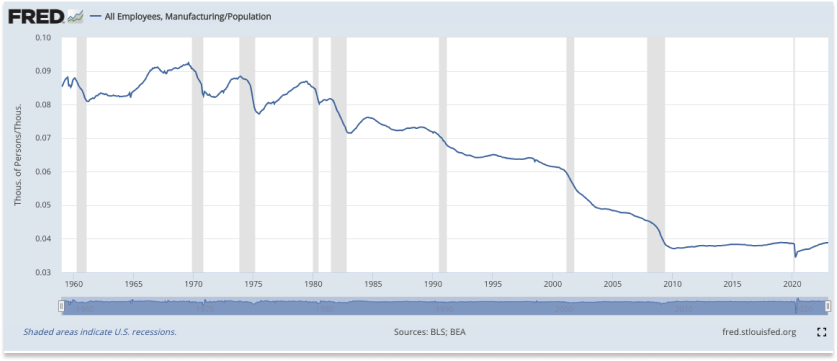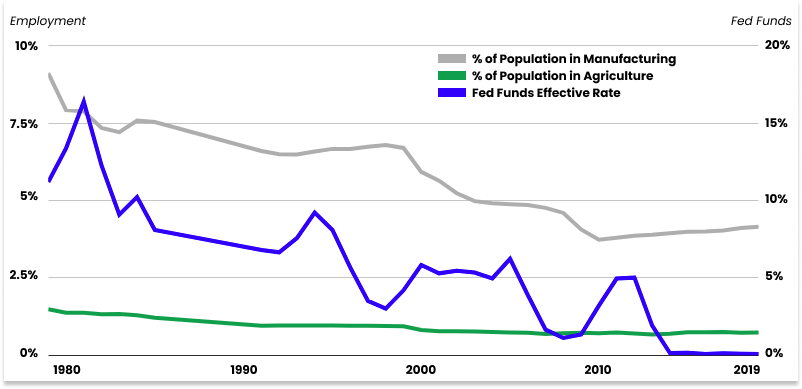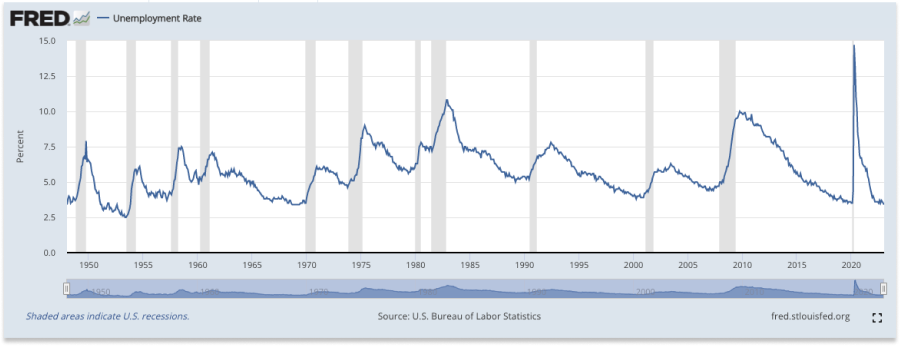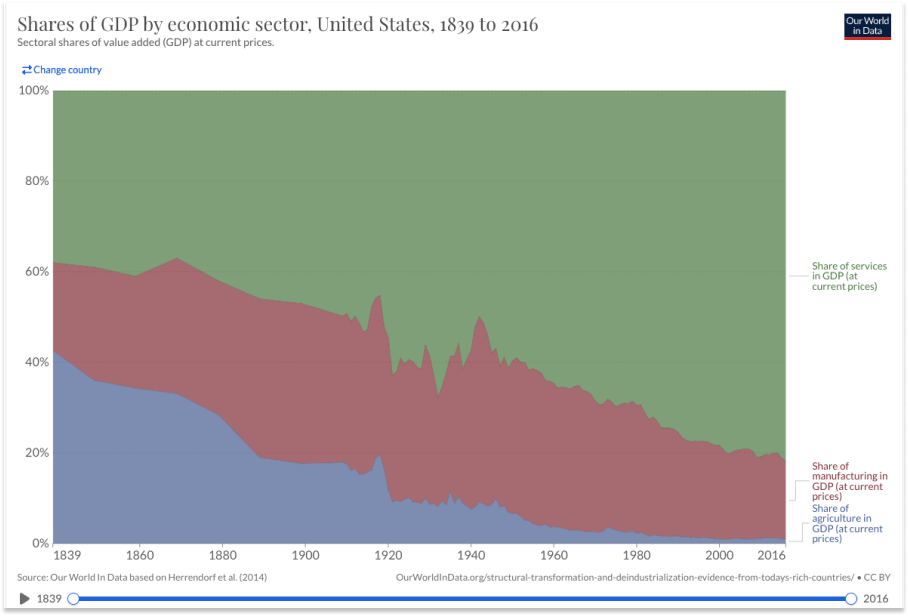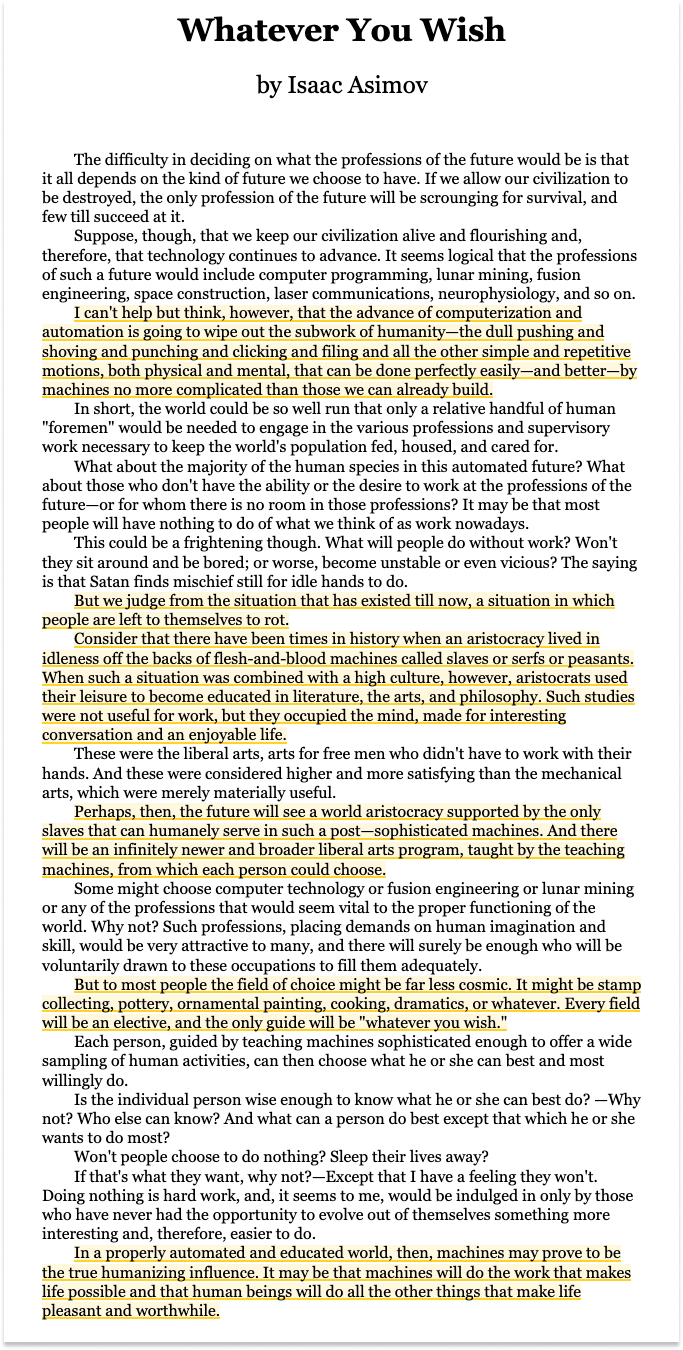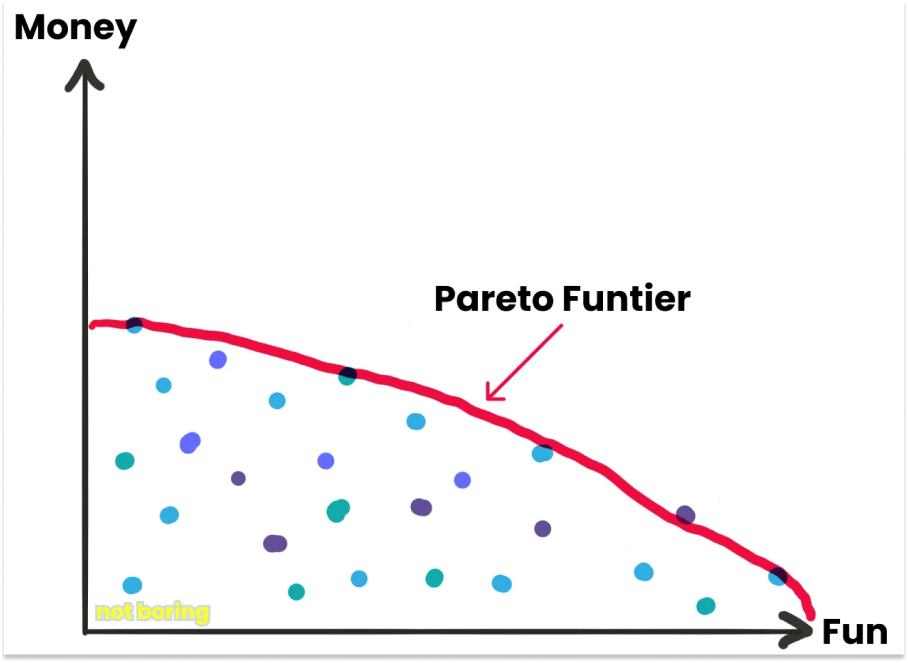Not Boring by Packy McCormick - The AppetiZIRP
Welcome to the 1,343 newly Not Boring people who have joined us since last Tuesday! If you haven’t subscribed, join 188,230 smart, curious folks by subscribing here: Quick note: This post might cut off in your inbox. Click “The AppetiZIRP” at the top to jump to the online version and read the whole thing. Today’s Not Boring is brought to you by… Composer You know Composer. I love Composer — the investing app that helps you achieve superior returns with logic and data. Since founding its algorithmic trading platform in 2020, Composer has helped over 20,000 customers trade 100s of millions of dollars. I’m one of them — my Composer portfolio is actually up since I started using it last year, which is incredible because the portfolio of individual stocks I own is … not. Here’s what I like about using Composer:
As a Not Boring reader, you can get an extra free week of Composer’s trial offering by entering “Not Boring” in the “Where did you hear about us?” section. This exclusive offer lasts until Friday 3/3 at 11:59pm EST, so check out Composer now: Hi friends 👋, Happy Tuesday from snowy Brooklyn! I have a bunch of goals for this newsletter. Our mission is to make the world more optimistic. I want to invest in and tell the stories of companies that are bending the world’s trajectory upwards. But there’s one immediate short-term thing I really want to get across: the world is going to keep getting much weirder, really fast. Instead of dismissing the latest Weird New Thing as a fad or temporary (transitory?) insanity, I want you to see that the Weird New Thing is just a small taste of a Much Weirder Future Thing. I want you to start taking weird shit more seriously. We’re in the middle of one of those “everything is changing” times. And in times like these, it’s helpful to zoom out, look back, and look forward. It’s impossible to predict the future with any meaningful accuracy, but it is possible to take the present much more seriously. Let’s get to it. The AppetiZIRPLet’s start with a hot take: ZIRP Phenomena are really just little glimpses into the future. AppetiZIRPs, if you will, for the much wilder main course. The conversation around the Fed’s Zero Interest Rate Policy, or ZIRP, typically runs in one causal direction. The Fed lowered rates to avert crisis and kept them low for a decade. That led to all sorts of wacky behavior. With rates going back up, the wacky behavior will go away, the temporary insanity will stop, and we’ll look back and laugh at all of the silly things people did back then. We’re already laughing. “X was a ZIRP phenomenon” has become a meme on Twitter. My friend Austin asked for, and received, a bunch of examples here:  Zero interest rate phenomena:
1. NFTs
2. Starting a podcast
3. Miami
4. Great resignation
5. Working as an engineer for all 5 big tech companies at once
What did I miss? That may be the correct lens through which to view the past few years. Very smart people seem to think so. But allow me to play Devil’s Advocate and argue the side that Justin Poirier laid out succinctly here:  Analyzing everything through the ZIRP lens might seem "big picture" but it's just a narrow lens on a big long term phenomenon. What if the causality runs in the other direction? In that telling, we live in a world in which fewer and fewer people need to work to meet humanity’s basic survival needs. At least, in America, we live in a country in which fewer and fewer Americans need to work to meet Americans’ basic survival needs, thanks to a combination of increased productivity and globalization. As a rough proxy, the percentage of Americans who work in agriculture and manufacturing has shrunk dramatically over the past couple of centuries. Each has halved again in just the past forty years, during which rates have been in a steady downtrend. What if the proportion of the population needed to meet our basic needs is the prime mover, and rates are a response? Through this lens, low rates and ZIRP are kind of like indirect, trickle-down Universal Basic Income (UBI), keeping people employed in jobs that would have looked like luxuries, or even games, to our fairly recent ancestors. In just the past ~30 years, the number of employees needed to generate $1 million in revenue at S&P 500 companies has been quartered, from eight in 1985 to two in 2022. I’m not sure if this chart is adjusted for inflation – if not, adjusting for 2.78x inflation over the period would make it look a lot less severe – but in either case, even the number of people in these newer, fancier jobs needed to produce newer, less survival-critical goods and services is declining. And while it’s relatively easy to increase rates, it’s hard to see the trend towards fewer people being required to meet any type of need slowing down any time soon. In Power to the Person, I predicted that “Within two decades, we will have multiple trillion-plus dollar publicly traded entities with just one full-time employee, the founder.” If you believe the AI accelerationists, or even the AI safety folks, I may have been too conservative. We might be approaching a world in which an entity with zero “humans” can create untold value or destruction.  a new version of moore’s law that could start soon:
the amount of intelligence in the universe doubles every 18 months I’m nowhere near smart enough to set a timeline on AGI. Some people think it’ll be here by 2025; others think it will be decades. And since we’re bad at predicting the impact of even technologies that we understand, I’m not going to try to predict the impact of one that we don’t really. But zooming out and putting a fuzzy end date on the graph, there’s a point in the future at which the productivity per person looks like this: So what do we do when we actually need very few people to work to make the economy go? The person who might have the biggest hand in bringing about that future has an idea. On Friday, OpenAI’s Sam Altman wrote a post titled Planning for AGI and beyond in which he lays out the company’s plans to balance AI progress and safety. Near the end of the piece, he includes a little aside on how the company might help workers displaced by AGI. Its nonprofit can override for-profit interests, and do things like “sponsor the world’s most comprehensive UBI experiment.” UBI is a way to spread the wealth when fewer people and companies produce and capture more economic value. Like, say, if one company develops an AGI that can do everything that people used to do, UBI would be a way to take a bunch of the money they make and give it to everyone so they can keep living and buying stuff. UBI is ZIRP on steroids rolled up with perma-stimmies. Instead of saying, “Here, you can borrow money for practically nothing but you’ll need to pay us back,” UBI says, “Here, take this money.” It’s how, for all intents and purposes, this popular rates chart goes from this: To this… If you think that the creator economy or monkey jpegs or tech PM day in the life TikToks were ZIRP Phenomena, wait until you see what people do with their time when they get paid just to be alive. UBI Phenomena will make ZIRP Phenomena look quaint. Now, as I will caveat many times here, while I studied econ in college, I am not an economist. The economists among you are likely yelling all the reason rates have declined for the past forty years at your computer screens. Rates were super high in 1980! Globalization! Aging population! Savings glut! Marginal Revolution readers might even point out that Total Factor Productivity growth has been anemic since 1973. Even that point, though, is debatable, since the blog post Tyler Cowen links to in his post argues that TFP might be off because it’s harder to measure outputs from services and technology, which have made huge gains in their share of the economy. I’m just going to keep it stupid simple and look at how many Americans it takes to meet Americans’ basic needs for food and things, and extrapolate from there, and assume that something similar is going to happen to knowledge work, too. In The Enchanted Notebook, I wrote about Ray Kurzweil’s superpower:
It’s easy to get caught up in the short-term stuff and miss the bigger picture, so at the risk of looking very stupid, we’re going to Trust the Curves, before turning to some of my favorite sci-fi writers to see where those curves might be leading us. Fewer People Are Keeping Us AliveOver the past couple of centuries, the proportion of Americans working to meet the population’s basic needs has declined dramatically thanks to scientific and technological innovation, automation, and globalization. So we invented new jobs, and financialized the economy, to meet brand new needs higher up Maslow’s Hierarchy and to keep people busy and filled with meaning. Many of those jobs are now on the cusp of being automated away too. The most incredible stat I’ve come across on this front comes from Vaclav Smil’s How the World Really Works: “the share of the US population working as farmers declined from 83% in 1800 to 1% today.” That is unbelievable. I want you to pause and take a second to think about it. That means that 223 years ago, 83 out of every 100 of us would have essentially had to grow our own food to survive, and we no longer do, so we can do all sorts of other things. I just read Tim Urban’s book, so I’ll show you how crazy that is using stick figures. A lot has happened between then and now. We didn’t go to bed farmers one day and wake up newsletter writers the next. So I pulled some data to show what that chart looks like over time (Our World in Data ag data starts in 1840, so I used Smil’s 1800 number):
Share of workers in agriculture is not a perfect measure of the health of the economy or progress. There are conflating factors, like the fact that at some point on this graph we started importing more food. But I think it’s a really interesting one, because it shows the percentage of the population focused on meeting people’s most basic need: food. Food is energy, and without it, we die and nothing else matters. All sorts of inputs go into this graph: mechanization, automation, biology, chemistry, factory farming. The output is that it takes fewer people to feed more and more people. And the fewer people working on feeding us, the more people to work on satisfying other needs, for others or for themselves. The Industrial Revolution was a major driver of the need for fewer farmers, and a major recipient of former farmers. By 1910, 32% of non-farm employees worked in manufacturing. By 1959, when FRED’s data starts, somewhere between 8-9% of all Americans (working or not, everyone) were employed in manufacturing. Then around 1980, that percentage began to drop. Today, less than 4% of the population works in manufacturing. Again, this data isn’t perfect. The US signed a bilateral trade agreement with China in 1979, for example, so this chart is as much a result of outsourcing as it is automation or efficiency. But the rough takeaway is that dramatically fewer Americans work to feed and make things for the growing population. And if you zoom in on the period when rates start their four-decade downtrend, right around 1980, the percentage of people making our things and growing our food each got cut in half over the four decades during which rates steadily declined. For the third time, this is messy data! Correlation-causation alarm bells are blaring! Outsourcing and global trade play a big role! It’s not just productivity gains! BUT if you stick with me here, you can see that more jobs doing things we need to survive are being automated (or outsourced) away, and rates are declining. At the same time, the US employment rate is lower than it’s been since the 1950s. Where are all the new jobs coming from? The biggest gainers, where both the number of total jobs and the category’s percentage of total nonfarm jobs are higher in 2023 than 1980, are:
Trade, Transportation, and Utilities (+10.363 million) and Government (+6.188 million) are both up, but have seen their share of the overall pie shrink. You can play with the data here if you want to dig in further. Other than healthcare, which is its own special clusterfuck, this is really interesting to me because it looks like everything is moving up a layer or two of abstraction and down a layer or two of necessity. Fewer people making things, more people managing things being made, managing the money from those things being made, and cleaning and fixing the things that were made. Fewer people growing food, more people serving other people food. That’s not surprising. Services – including everything from hospitality to professional and business services to financial activities – have been steadily eating US GDP since as far back as Our World in Data’s chart goes. Services as a percentage of GDP have doubled from ~40% in 1839 to ~80% today. Over the past couple of centuries, and certainly over the past forty-odd years, as fewer people have had to work hand-to-mouth or hand-to-machine, the economy has had to support an increasing proportion of jobs that aren’t entirely necessary to our survival. And that’s great! The point of progress is to move more people up the hierarchy of needs. The poorest among us have things that Kings and Queens couldn’t have dreamed of even a century ago. As automation marches on, even as we dream up newer and weirder jobs for ourselves (I write an email newsletter!), the proportion of necessary jobs shrinks. And now, it looks as if AI is coming for those less necessary knowledge work jobs. It might even come after manual service jobs soon…  In 5 years, I believe humanoid robot hardware will finally cross the uncanny valley - so lifelike that you cannot tell if it’s real (i.e. passing the appearance Turing test).
Left: @clonerobotics hand
Right: Ameca from Engineered Arts
Westworld won’t stay sci-fi for too long. https://t.co/XuYOBu0T3e What is everyone going to do for work when the robots can fulfill our basic needs, and then some? Luckily, this is a question that sci-fi writers have been wrestling with for a long time. Vonnegut and Asimov Predict the FutureIs automation going to lead to a depressing, meaningless future of work or a beautiful world of aristocratic abundance for all? It depends if you believe Kurt Vonnegut or Isaac Asimov. Kurt Vonnegut came out swinging. In his 1952 debut novel, Player Piano, he described a near-future America in which automation has created widespread unemployment, unrest, and ennui. The engineering-inclined held jobs maintaining the machines and directing their output. Everyone else was left with two choices: join the Army, or work for the Reconstruction and Reclamation Corps. What did members of the Reconstruction and Reclamation Corps do? Glad you asked, because that’s the image that’s been glued to my otherwise spotty memory ever since I read the book. They dug holes in the road, and then they filled them back in. Vonnegut was clearly inspired by two experiences, one personal and one national. After serving in World War II, and before quitting to try his hand at writing, Vonnegut spent three years at General Electric, where he worked alongside engineers who wanted to automate everything. According to the person who interviewed him for Playboy in 1973, “It seemed to him that scientists in those days wanted to mechanize everything and take care of everybody.” Before that, during his teenage years in the 1930s, Vonnegut saw Franklin D. Roosevelt’s Works Progress Administration use federal funds to employ millions of unemployed Americans in public works projects to help overcome a temporary Great Depression. Player Piano asked, “What if the GE engineers get their way?” and answered with a nihilistic twist on the WPA. As Vonnegut told Playboy:
If we reach the point, in a decade or a century, when most people don’t need to work to make a living for society to function, what will we do with all of our time? Whence will we get dignity? Writing a decade after Vonnegut, Isaac Asimov saw a similar fate for human employment – no longer necessary, really – but imagined a very different, more optimistic outcome. In Whatever You Wish, which is so excellent that I’m just going to include the whole thing here, he wrote, “I can’t help but think, however, that the advance of computerization and automation is going to wipe out the subwork of humanity – the dull pushing and shoving and punching and clicking and filing and all the other simple and repetitive motions, both physical and mental, that can be done perfectly easily – and better – by machines no more complicated than those we can already build.” While acknowledging that the thought of being automated out of a job could be “frightening,” Asimov envisioned a world in which machines allow humans to be more human. Instead of doing what we have to do to survive, humans might spend their time like aristocrats of old, becoming “educated in literature, the arts, and philosophy.” Of course, people could choose impactful work in fields like “computer technology or fusion engineering or lunar mining or any of the professions that would seem vital to the proper functioning of the world,” but that would be entirely up to them. “Every field will be an elective, and the only guide will be ‘whatever you wish.’” As we hurtle towards that automated future, the question is: whose vision is more right, Vonnegut or Asimov? The general dialogue around automation would suggest that Vonnegut’s is the more popularly held. I’ve written about the fear that robots will steal factory jobs, despite evidence to the contrary. Each recent advance in AI’s capabilities have been met with concerns about the economic prospects for artists, writers, MBAs, lawyers, and even doctors. If Vonnegut’s right, we’ll end up unemployed, undignified, unsatisfied, unfulfilled. Maybe we’ll dig some holes, and fill them back in. But me, I think that Asimov was more prescient. His vision is kind of already happening now. We’re just wrapping “whatever we wish” in games masquerading as jobs. The Present and Far Future of WorkWe’re still some years away from computers and robots wiping out the subwork of humanity, so the jury is still out, but I think if Asimov missed something, it’s that humans are competitive animals who derive meaning from work. Maybe this, too, will change with time, but until thousands of years of evolution’s hard wiring are re-wired, I assume we’ll want to keep striving towards something. My guess is that work and games are going to continue to blend. My most popular essay ever, The Great Online Game, touched on this idea a bit. The internet is like a big, global game with real-world consequences. But what I’m talking about here is a little different. A couple weeks ago, I was listening to Episode 4 of the excellent Gamecraft podcast from Benchmark’s Mitch Lasky and Blake Robbins when I found a set of criteria that fit even better. The episode was titled “The Forever Games,” and near the very beginning, Lasky laid out the five key attributes of Forever Games, “games designed to last for a really long time.”
Not every Forever Game needs to be 100% on every category, but they need to have at least a little of each, and ideally a lot of some. That framework fits a lot of the jobs that have become more popular since the 1800s, and especially over the past forty years. Hedge funds are an obvious example, but many less obvious ones fit, too. Academia, product management, certainly newsletter writing. Think about your job: would you say it’s more “life or death” or “game-like”? When I asked that question on Twitter, 81% of respondents went with game-like: At the same time, games are becoming more like work. In The New Gold Rush, Lasky and Robbins described economic play in games like EVE Online, in which players formed mini-economies, complete with division of labor and assigned jobs. Even in virtual worlds, with no real stakes, people find ways to work together to create things they can’t on their own. Not everyone will play games, directly or wrapped-as-work. As Asimov predicted, there will always be people who want to dedicate their lives to solving the hardest challenges facing humanity – like nuclear fusion, lunar mining, and the whole Good Quests list. I want to fund them and help tell their stories, and I hope that a consequence of persistently low rates and software automation, if that comes to pass, is that resources can flow to the companies that need a lot of capital to achieve really hard and important things. But many others are already engaged in jobs that require an applied version of Asimov’s broad liberal arts program. Learn broadly, and apply the knowledge to games wrapped up as work. I’ll pick on myself here. I get to spend my days reading, having conversations with really smart people, making “art,” and writing. My days sound a lot like what Asimov predicted they would. But I need to make a living and feel like I’m making some sort of difference, so I send this newsletter to 188k people and try to grow it and find sponsors and compete to invest in companies that have a shot at making life better for humans and try to help them win. It’s a modern aristocratic life, wrapped in a work game. Not Boring – the newsletter and the Fund – could be considered a ZIRP Phenomenon. Some random guy sits in his house writing and investing instead of building something with his bare hands. But if I had to bet, I’d guess that the jobs of the future look more like Not Boring, and even weirder. We’ll continue to push out the Pareto Funtier, with “fun” defined for each person as “whatever you wish.” If Altman, Vonnegut, Asimov, and Banks are right and we land in a spot where people don’t need to work, they’ll still need to find meaning. They’ll still want to compete, and outperform their neighbors. Most billionaires continue working long after they have to. That world, if it comes to pass, will make ZIRP Phenomena look like the good ol’ days, when people rolled up their sleeves and made an honest living. When no one has to work to survive, the things we make up to keep ourselves busy will look increasingly silly. But we’ll take them really fucking seriously. The love of the game will create meaning, community, and yes, consumption. And when those games get old, we’ll create newer, wilder ones. Of course, I hope that people will take advantage of the need to work less to actually work less, to spend more quality time with their family and friends, to explore the world and connect with a higher purpose. As we pointed out in last week’s Weekly Dose, one consequence of increased productivity has been that most people work less: college, retirement, and weekends are all relatively recent phenomena. This trend, too, will likely continue. We’ll get to play games for work and work less, if we wish. Long before AGI, there are nearer-term implications that will impact many of us. I’ve written about a couple of them this year, in Differentiation and Love in the Time of Replika. Over the next few weeks, I have a few more planned out. I suspect that a lot of what I write in this newsletter in the coming months and years will be about the businesses bringing about this weird, abundant future and what will be different when they do. If this really is one of those “everything is changing” moments, it’s going to keep me busy and employed… until it takes my job, too. Thanks to Dan for editing! That’s all for today! We’ll be back in your podcast feeds this week and your inbox on Friday for that Weekly Dose of Optimism. Thanks for reading, Packy Not Boring by Packy McCormick is free today. But if you enjoyed this post, you can tell Not Boring by Packy McCormick that their writing is valuable by pledging a future subscription. You won't be charged unless they enable payments. |
Older messages
Weekly Dose of Optimism #31
Friday, February 24, 2023
4 Day Work Week, Freak Trees, Quantum Computing, Technological Progress, Necessary Immigration, and Anti-Doomerism.
Love in the Time of Replika
Tuesday, February 21, 2023
Why crypto and AI are perfect bedfellows, actually
Weekly Dose of Optimism #30
Friday, February 17, 2023
What's Our Problem, T1D, Alzheimer's Detection, Binge Drinking, Beautiful Information
Tell Good Stories
Tuesday, February 14, 2023
Rahul on Sci-Fi, Spectacles, and Making the Frontier Not Boring
Weekly Dose of Optimism #29
Friday, February 10, 2023
Stable Attribution, Indian Industrialization, Trikafta, Florida Man, Solar Capacity, Go Birds
You Might Also Like
🔮 $320B investments by Meta, Amazon, & Google!
Friday, February 14, 2025
🧠 AI is exploding already!
✍🏼 Why founders are using Playbookz
Friday, February 14, 2025
Busy founders are using Playbookz build ultra profitable personal brands
Is AI going to help or hurt your SEO?
Friday, February 14, 2025
Everyone is talking about how AI is changing SEO, but what you should be asking is how you can change your SEO game with AI. Join me and my team on Tuesday, February 18, for a live webinar where we
Our marketing playbook revealed
Friday, February 14, 2025
Today's Guide to the Marketing Jungle from Social Media Examiner... Presented by social-media-marketing-world-logo It's National Cribbage Day, Reader... Don't get skunked! In today's
Connect one-on-one with programmatic marketing leaders
Friday, February 14, 2025
Enhanced networking at Digiday events
Outsmart Your SaaS Competitors with These SEO Strategies 🚀
Friday, February 14, 2025
SEO Tip #76
Temu and Shein's Dominance Is Over [Roundup]
Friday, February 14, 2025
Hey Reader, Is the removal of the de minimis threshold a win for e-commerce sellers? With Chinese marketplaces like Shein and Temu taking advantage of this threshold, does the removal mean consumers
"Agencies are dying."
Friday, February 14, 2025
What this means for your agency and how to navigate the shift ͏ ͏ ͏ ͏ ͏ ͏ ͏ ͏ ͏ ͏ ͏ ͏ ͏ ͏ ͏ ͏ ͏ ͏ ͏ ͏ ͏ ͏ ͏ ͏ ͏ ͏ ͏ ͏ ͏ ͏ ͏ ͏ ͏ ͏ ͏ ͏ ͏ ͏ ͏ ͏ ͏ ͏ ͏ ͏ ͏ ͏
Is GEO replacing SEO?
Friday, February 14, 2025
Generative Engine Optimization (GEO) is here, and Search Engine Optimization (SEO) is under threat. But what is GEO? What does it involve? And what is in store for businesses that rely on SEO to drive
🌁#87: Why DeepResearch Should Be Your New Hire
Friday, February 14, 2025
– this new agent from OpenAI is mind blowing and – I can't believe I say that – worth $200/month
